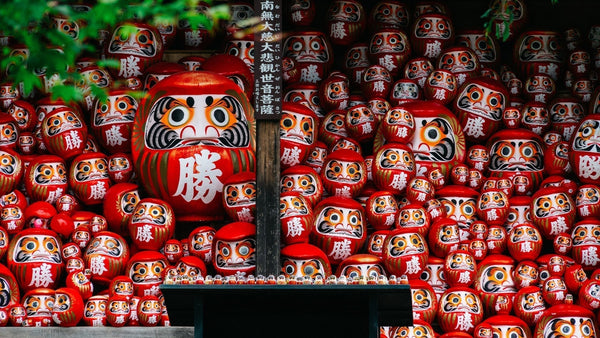
Jump to:
Few objects represent Japanese perseverance and optimism as clearly as the Daruma doll.
These round, wide-eyed figures aren’t just some kind of souvenir shop gimmick. They carry centuries of history and a deep meaning that continues to resonate in Japanese culture.
But what exactly is a Daruma doll? How did it come about to be? Why do you see that around when traveling in Japan, and why might you want to own one?
In this guide, you’ll learn the origins of the Daruma doll, why it’s closely linked to perseverance and goal-setting, what its colors and rituals symbolize, and where to find authentic artisan-made Daruma.
By the end, you’ll understand not just what a Daruma is but why it still matters in Japan today and how it can motivate your own goals and everyday life.
What Is a Daruma Doll: Origins and History

The Daruma doll traces its origins to Bodhidharma, a 6th-century Buddhist monk from India who founded the Zen school of Buddhism in China.
Legend says he meditated for nine years facing a wall to reach enlightenment. His stalwart, constant focus became the foundation of the Daruma’s symbolism.
In Japan the story was adapted and celebrated.
Craftsmen in Takasaki (in Gunma Prefecture) began producing paper mache Daruma dolls in the 17th century. These dolls were modeled after Bodhidharma’s face and robes. Over time they became a symbol of good fortune and resilience, reflecting the Japanese phrase nanakorobi yaoki … “fall down seven times and get up eight!”
This enduring, fighting spirit is still seen in Japan today, in concepts like “gaman” (endurance & pushing through hardship ) and “ganbaru” (fighting the good fight to overcome one’s challenges).
What Does the Daruma Doll Represent in Japanese Culture?

A Daruma doll represents persistence, goal-setting and good luck.
When you buy a Daruma, both eyes are blank. The owner paints one eye while making a wish or setting a goal. The second eye is filled in only when that goal has been achieved.
Why??
Well, the idea is simple: keep the one-eyed Daruma somewhere visible as a reminder to stay focused and not give up.
Because Daruma dolls are weighted at the bottom, they always return upright when pushed over. This design reinforces the message of perseverance and determination.
The combination of shape, symbolism and ritual makes the Daruma a constant presence in Japanese homes, offices and temples.
Daruma Doll Colors and Their Meanings

The traditional Daruma is bright red, a color historically linked to monks’ robes and to the belief that red wards off evil and illness.
Today you can find Daruma dolls in many colors each carrying its own meaning:
- Red: Good fortune and protection
- Gold: Wealth and prosperity
- White: Purity and new beginnings
- Black: Warding off bad luck
- Pink: Love and harmony
Though most have bearded faces and wide eyes, regional artists interpret the design differently. Some Daruma dolls are round and smooth while others have textured or painted patterns reflecting local styles.
Where to Buy Authentic Daruma Dolls

Photo: Shorinzan Daruma Temple by visit-gunma.jp
Authentic Daruma dolls can be found at temples, craft fairs and local shops that work with Japanese artisans.
If you’re not in Japan, you can still purchase authentic Daruma dolls online through Japanese Taste, including our Daruma doll and Shirakawa Daruma doll collections. These are handcrafted in Japan and available in different sizes and colors to match your goals or décor.
When choosing a Daruma doll, you might want to think about its size and color as a reflection of your personal aspiration. A large red Daruma for long-term goals, a small gold one for financial growth, or a white one for a fresh start. The choice itself becomes a quiet act of intention.
How to Use a Daruma Doll for Goals and Good Luck

Photo: Shorinzan Daruma Temple by visit-gunma.jp
Owning a Daruma is less about decoration and more about practice.
At the start of a new year or when beginning a project, many Japanese people purchase a new doll and paint one eye while silently stating their wish or goal. They place it in a visible spot, such as a shelf, desk, or entryway, as a constant reminder to keep working toward that outcome.
When the goal is reached, the owner fills in the second eye to show gratitude and completion. It’s a simple yet satisfying ritual. Many people then take their Daruma to a temple for a ceremonial burning, expressing thanks before letting go of the past year’s challenges.
 At Katsuo-ji Temple in northern Osaka (as shown in the photo), thousands of Daruma dolls are offered every year in a grand ceremony that fills the hillside with red. The temple is known as the “Temple of Winning Luck”. This is one of the most famous sites in Japan to dedicate and burn Daruma dolls.
At Katsuo-ji Temple in northern Osaka (as shown in the photo), thousands of Daruma dolls are offered every year in a grand ceremony that fills the hillside with red. The temple is known as the “Temple of Winning Luck”. This is one of the most famous sites in Japan to dedicate and burn Daruma dolls.
Famous Temples and Places Connected to Daruma Dolls

Photo: Shorinzan Daruma Temple by visit-gunma.jp
Daruma dolls appear across Japan in temples, markets and small local shrines.
In Takasaki, the Shorinzan Daruma Temple is often called the birthplace of the modern Daruma. Each January the temple hosts a two-day Daruma Market where hundreds of vendors line the approach, selling hand-painted dolls of every size. The temple also houses a hall filled with Daruma offerings left by visitors who achieved their goals during the year.
In Tokyo, Jindaiji Temple near Chofu is another important site. It hosts the Jindaiji Daruma Fair each spring where crowds gather to buy new dolls and return old ones to be burned. Stalls line the temple path, selling amulets and snacks shaped like tiny Daruma heads. The festival has been celebrated for more than three centuries.
In Kyoto, the Bishamonten Temple in Kurama and the Rokkakudo Temple downtown both feature Daruma imagery as symbols of perseverance.
Travelers visiting Osaka or Kyoto may also see smaller Daruma displays at souvenir shops or even in train station kiosks where modern artisans adapt the design into charms, magnets and keychains.
These regional events, shrines and temples make the Daruma a spiritual item and a part of everyday travel in Japan. Whether it’s a grand market in Gunma or a quiet shrine in Kyoto, the same red figures remind visitors of focus and renewal.
Daruma and Food: How the Doll Appears in Japanese Cuisine

Photo: Daruma Bento by Junko Nagata, japanbyweb.com
Food and fortune are never far apart in Japan, and the Daruma’s presence can be felt even in what people eat.
During New Year fairs and Daruma festivals, vendors sell taiyaki, fish-shaped cakes decorated with Daruma faces. Red bean filling represents protection and sweetness for the year ahead.
Some bakeries in Gunma make “Daruma manju,” soft buns shaped like miniature dolls.
In Osaka, a long-running restaurant chain named Daruma uses the doll’s face in its logo as a promise of satisfaction and success. The name appears in izakaya pubs and food stalls too, especially during winter when people eat chanko nabe hotpot dishes that symbolize strength, a quality that matches the Daruma spirit.
Even bento shops occasionally release limited “Daruma Bento” lunch boxes during exam season. Inside, you might find red pickled ginger for luck or golden tamagoyaki for prosperity. The theme connects nourishment and determination, reminding people that effort and patience feed success the same way food feeds the body.
Regional Daruma Traditions and Local Variations

While Takasaki remains the best-known center for Daruma production, many regions have their own local versions.
In Fukushima, the Shirakawa Daruma has a longer face and a more subdued expression. In Kyoto and Osaka, smaller temples sell handmade Daruma painted by monks. Each area adds its own artistic character but the meaning remains consistent: hope, effort and renewal.
Festivals like the Takasaki Daruma Market in January attract thousands of visitors. People come to buy new dolls, return old ones and participate in prayers for good luck and safety in the coming year.
Craftsmanship Behind Daruma Dolls: Handmade Tradition
Each Daruma doll is handmade.
Artisans mold the papier-mâché body, apply layers of red paint, and hand-draw the facial features one by one. In an era of mass production, this human touch is part of what keeps the craft alive. For many families, the work has been passed down for generations.
Buying a genuine Daruma doll supports a cultural tradition as well as small Japanese workshops that rely on skill, patience, and pride in their craft.
More than a lucky charm, the Daruma doll is a compact expression of Japan’s belief in persistence and gratitude. Owning one means that its gaze serves as a daily reminder: stay patient, stay determined, and trust that your effort brings results.
Ganbare!


0 comments